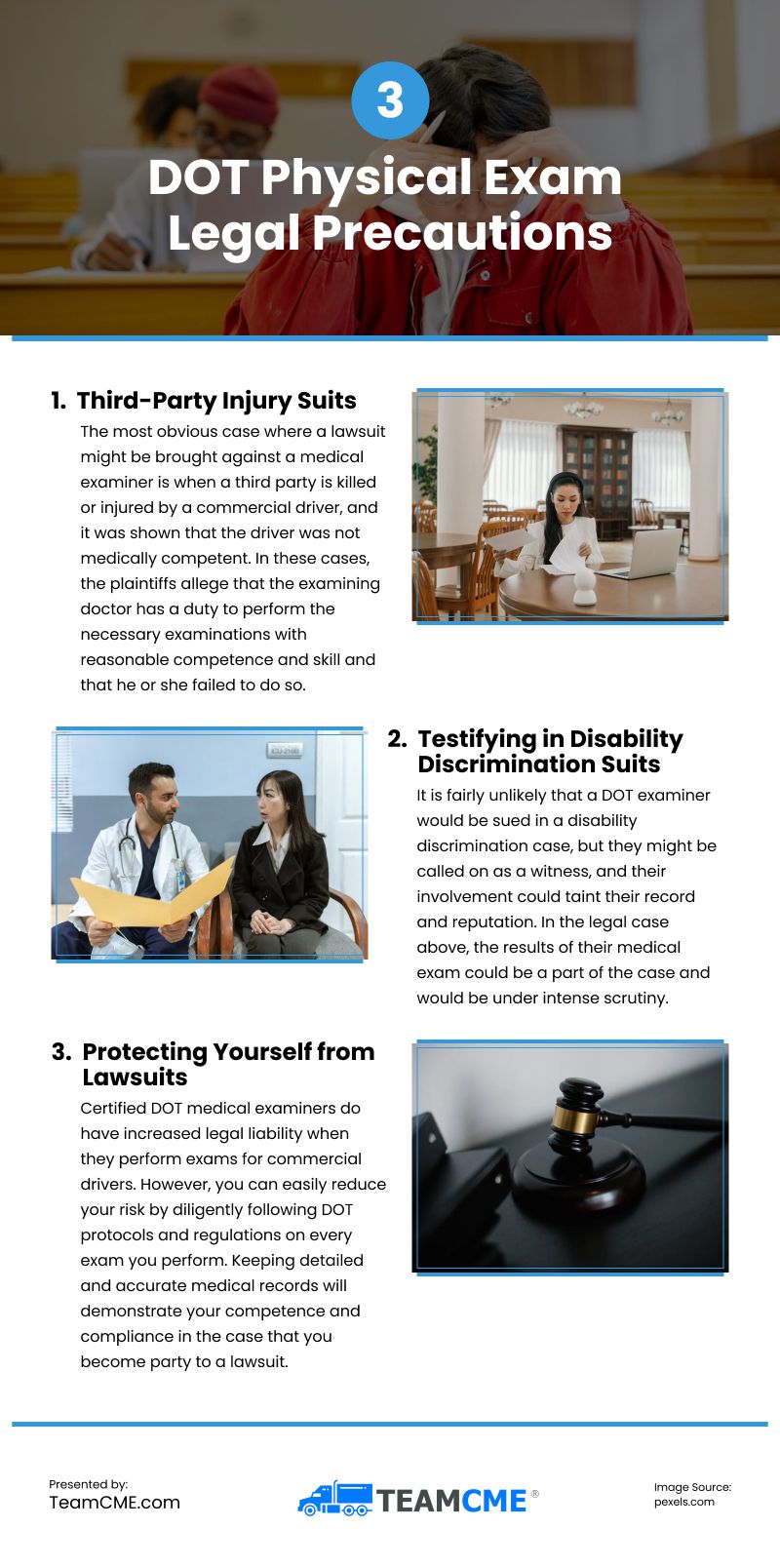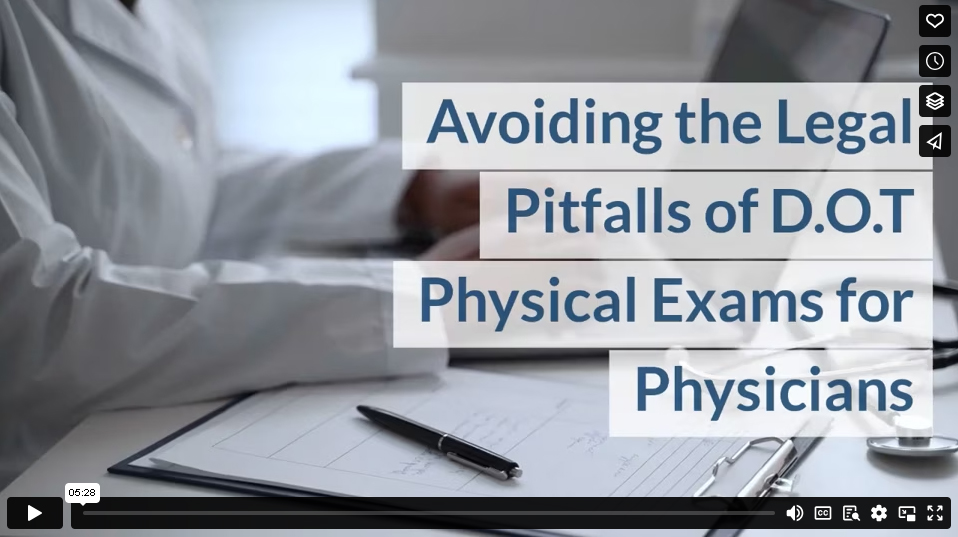Doctors who perform physical exams for commercial drivers need to be aware of their increased legal liability. Because of Department of Transportation (DOT) regulations, medical professionals performing DOT exams have unique legal exposure. Claims against medical examiners are rare, but as a certified medical examiner, it is something you should be aware of so you can take precautions to avoid any legal entanglements.
The simplest way to stay out of legal trouble is to perform a competent medical exam congruent with DOT regulations and standards. This is easy when using DOT exam software such as Simple Physical. If you use best medical practices on each exam you perform, you are very unlikely to have any problems. Even so, here are a few legal scenarios that you should be aware of and prepare for.
Third-Party Injury Suits
The most obvious case where a lawsuit might be brought against a medical examiner is when a third party is killed or injured by a commercial driver, and it was shown that the driver was not medically competent. In these cases, the plaintiffs allege that the examining doctor has a duty to perform the necessary examinations with reasonable competence and skill and that he or she failed to do so.
Every state and jurisdiction has slightly different rules, but past cases provide examples of how a medical examiner might be held liable. In Tennessee, in the case Wharton Transportation Co. v. Bridges, the commercial driver’s company (Wharton Transportation) filed a suit against the physician (Dr. Bridges). The driver, Lawson, applied for a commercial driving position with Wharton. Wharton sent Lawson to Dr. Bridges for a DOT physical examination, and Dr. Bridges approved Lawson for duty.
A short time later, Lawson was driving a Wharton vehicle when he pulled off the highway and collided with a station wagon parked on the side of the road. The accident resulted in the death of a child and serious injuries to the other three passengers. During settlement claims, Wharton discovered that Lawson’s vision was seriously impaired, and previous to his examination by Dr. Bridges, other doctors had determined that he was completely physically disabled. According to these other physicians, Lawson experienced 95% vision loss in one eye, blurred vision in the other, debilitating back pain, knee and ankle problems, and chronic fatigue and pain.
Lawson never should have been driving a vehicle at all, and Dr. Bridges admitted that he would have discovered these medical disqualifications if had exercised a reasonable amount of competence in the examination. It was determined that Dr. Bridges had a duty to the safety of the public in performing his examination and that in failing to provide a competent examination, he was legally responsible, in part, for the accident and the damage it caused.
This is an extreme example, but it does show that medical examiners who make a mistake or fail to perform a reasonable examination expose themselves to legal liability. The best way to mitigate this risk is for examiners to carefully follow the DOT examination protocol. Additionally, detailed notes and a thorough paper trail will help demonstrate a doctor’s competence if a suit is ever filed.
Testifying in Disability Discrimination Suits
It is fairly unlikely that a DOT examiner would be sued in a disability discrimination case, but they might be called on as a witness, and their involvement could taint their record and reputation. In the legal case above, the results of their medical exam could be a part of the case and would be under intense scrutiny.
In one legal case, the EEOC vs. Texas Bus Lines, a DOT examiner failed an applicant based on “morbid obesity.” As a result, the company decided not to hire the driver based on the medical examination, and the driver sued Texas Bus Lines for disability discrimination. While the medical examiner was not a party in the case, his testimony was required. The court noted that obesity is not a part of DOT regulations and criticized the physician for not following DOT protocol and using subjective observations to disqualify the driver.
The company was ordered to send the driver for re-examination with a different physician. While there was not a legal penalty for the examiner, it certainly exposed the doctor to poor press, loss of reputation, and potential loss of clients. Companies could be hesitant to send their drivers for examination with an examiner who had been criticized by the court.
As before, the best defense is to carefully follow the protocol and guidelines for DOT physicals. When examiners have diligently followed the regulations and made recommendations based on the DOT guidelines and best practices, they don’t need to worry about legal ramifications.
Protecting Yourself from Lawsuits
Certified DOT medical examiners do have increased legal liability when they perform exams for commercial drivers. However, you can easily reduce your risk by diligently following DOT protocols and regulations on every exam you perform. Keeping detailed and accurate medical records will demonstrate your competence and compliance in the case that you become party to a lawsuit. The easiest and safest solution is to use a DOT exam software such as Simple Physical. It guides medical examiners through the DOT physical exam, producing promts and alerts along the way to ensure a thorough and accurate certification determination.
Since DOT regulations can change frequently, it is important that you stay up to date on your DOT certification courses and participate in the necessary continuing education courses. It is also a good idea to discuss your insurance coverage with your insurance agent before conducting DOT medical exams.
If you take the proper steps to protect yourself from legal liability and conduct thorough exams using best practices, you don’t need to be afraid of taking on DOT medical exams. It provides an essential service to our communities and can be a valuable addition to your medical practice.
Video
Infographic
Conduct thorough medical exams that comply with DOT regulations to avoid legal issues. Following best practices minimizes potential problems. This infographic highlights key legal scenarios to be aware of and prepare for.








